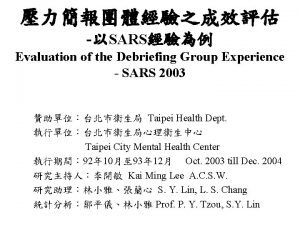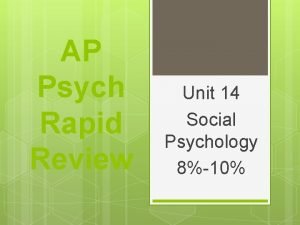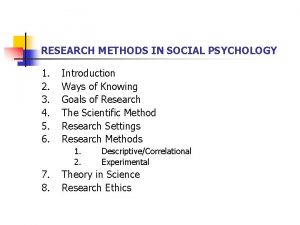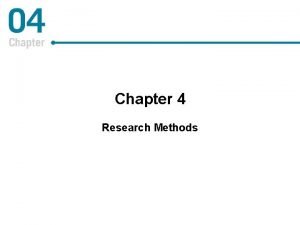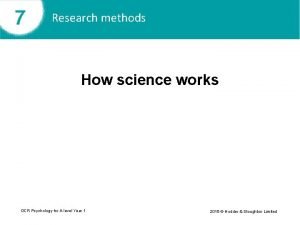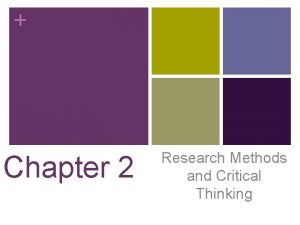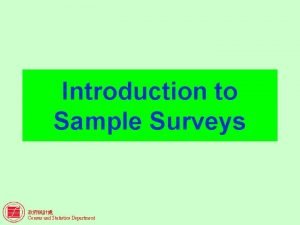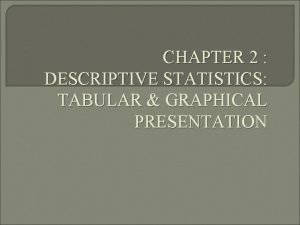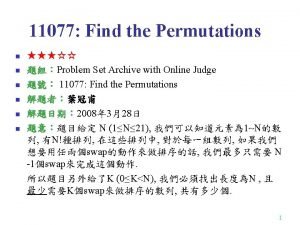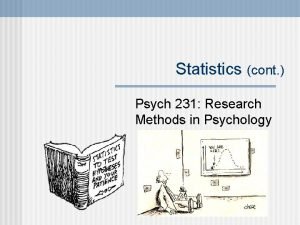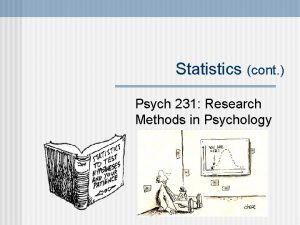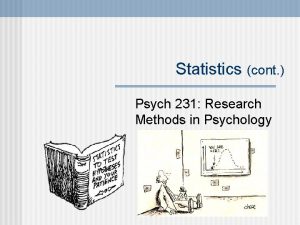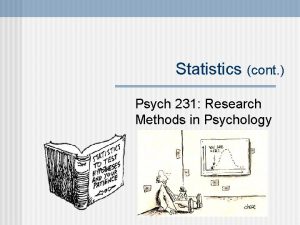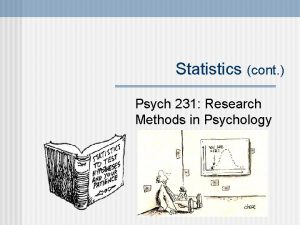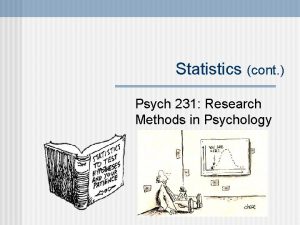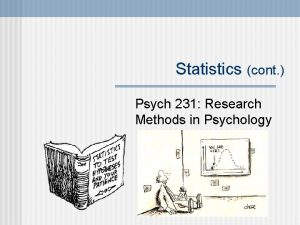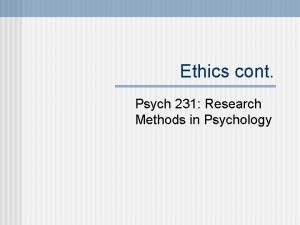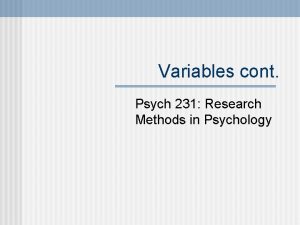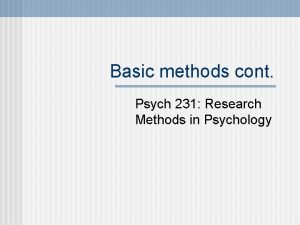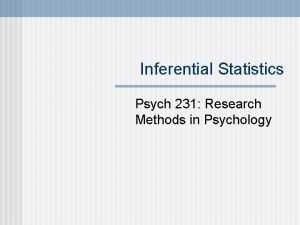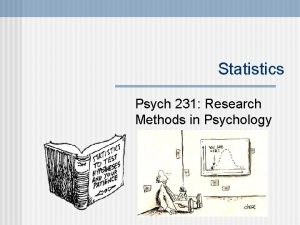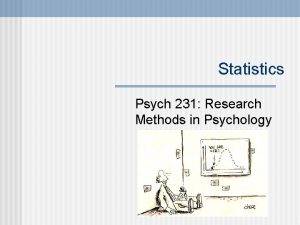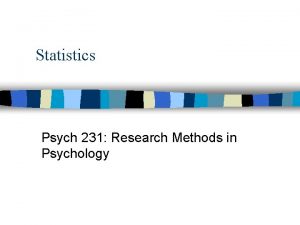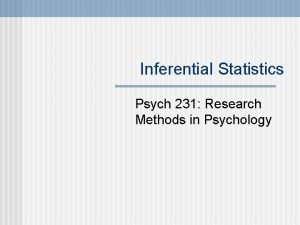Statistics cont Psych 231 Research Methods in Psychology

















- Slides: 17

Statistics (cont. ) Psych 231: Research Methods in Psychology

n n Quiz 10 is due on Friday at midnight Class experiment final drafts due in labs this week n Please remember to include your commented first draft Announcements

n Two approaches • Hypothesis Testing Population Dep Var • “There is a statistically significant difference between the two groups” Inferential statistics used to generalize back • Confidence Intervals Error bars are 95% CIs • “The mean difference between the two groups is between 10 ± 4” Sample A Treatment X = 45 Inferential Statistics Sample B No Treatment X = 35

n Design n n 2 separate experimental conditions Formulae: Observed difference Dep Var t= Error bars are 95% CIs X 1 - X 2 Diff by chance Based on sampling error: Estimate of the Standard Error CI: μ=(X 1 -X 2)±(tcrit)(Diff by chance) Two group design: HT & CI

n Design n n 2 separate experimental conditions Formulae: Dep Var T= X 1 - X 2 Diff by chance Margin of error Error bars are 95% CIs (with a level of confidence) CI: μ=(X 1 -X 2)±(tcrit)(Diff by chance) Two group design: HT & CI

CI: μ = (X) ± (tcrit) (diff by chance) – What DOES “confident” mean? » “ 90% confidence” means that 90% of the interval estimates of this sample size will include the actual population mean 9 out of 10 intervals contain μ Actual population mean μ Interpreting Confidence intervals • • R-Psychologist: Interpreting Confidence Intervals Tan & Tan (2010). The correct interpretation of confidence intervals. Procedings of Signapore Healthcare, 19. Retrieved https: //journals. sagepub. com/doi/pdf/10. 1177/201010581001900316

CI: μ = (X) ± (tcrit) (diff by chance) Note: How you compute your standard error will depend on your design Using Confidence intervals

CI: μ = (X) ± (tcrit) (diff by chance) Distribution of the test statistic Confidence interval uses the tcrit values that identify the top and bottom tails. Depends on: n α-level n df (degrees of freedom) The upper and lower 2. 5% A 95% CI is like using a “two-tailed” t-test with α = 0. 05 2. 5% 95% of the sample means Using Confidence intervals

CI’s in SPSS output for t-tests

n In text (APA style) example: n Important point! In graphs as error bars M = 30. 5 ms, 95% CI [18. 0, 42. 0] n In tables (see more examples in APA manual) Error Bars: Reporting CIs

Note: Make sure that you label your graphs, let the reader know what your error bars are n n Important point! In graphs as error bars Two types typically n Standard Error (SE) • diff by chance n Confidence Intervals (CI) • A range of plausible estimates of the population mean CI: μ = (X) ± (tcrit) (diff by chance) Error Bars: Reporting CIs

n Because C. I. s are often recommended or required: – “estimates of appropriate effect sizes and confidence intervals are the minimum expectations” (APA, 2009, p. 34) – Loftus (1993) – took over as editor or Memory & Cognition • “Data analysis: a picture is worth a thousand p-values” (pg. 3) – an editorial in Neuropsychology stated that “effect sizes should always be reported along with confidence intervals” (Rao et al. , 2008, p. 1) – In 2005, the Journal of Consulting and Clinical Psychology (JCCP) became the first American Psychological Association (APA) journal to require statistical measures of clinical significance, plus effect sizes (ESs) and associated confidence intervals (CIs), for primary outcomes (La Greca, 2005) – For journals in fields like medicine, physics, chemistry, CIs are the standard Estimation: Why?

n Some argue that CIs are more informative than p-values Hypothesis testing & p-values • Dichotomous thinking – Yes/No reject H 0 (remember H 0 is “no effect”) Neyman-Pearson approach • Strength of evidence Fisher approach Brief wiki description of these two approaches Confidence Intervals • Gives plausible estimates of the pop parameter (values outside are implausible) • Provide information about both level and variability • Wide intervals can indicate low power • Good for emphasizing comparisons across studies (e. g. , meta-analytic thinking) • Can also be used for Yes/No reject H 0 Estimation: Why? Geoff Cumming: • Introduction to Estimation: https: //www. youtube. com/watch? v=OK 6 DXf. Xv 8 BM

• If we had instead done a hypothesis test on 2 independent samples with an α = 0. 05, what would you expect our conclusion to be? H 0: “there is no difference between the groups” MD = 2. 23, t(34) = 1. 25, p = 0. 22 MD - Fail to reject the H 0 5. 9 -1. 4 = 2. 23, 95% CI [-1. 4, 5. 9] 0 Hypothesis testing with CIs

• If we had instead done a hypothesis test on 2 independent samples with an α = 0. 05, what would you expect our conclusion to be? H 0: “there is no difference between the groups” MD = 2. 23, t(34) = 1. 25, p = 0. 22 MD -1. 4 = 2. 23, 95% CI [-1. 4, 5. 9] MD = 3. 61, 95% CI [0. 6, 6. 6] - Fail to reject the H 0 5. 9 0 0. 6 - reject the H 0 6. 6 MD = 3. 61, t(42) = 2. 43, p = 0. 02 Hypothesis testing with CIs

P < 0. 05, so reject H 0 Doesn’t include 0 in interval, so reject H 0 P < 0. 05, so reject H 0 P > 0. 05, so fail to reject H 0 Does include 0 in interval, so fail to reject H 0 CI’s in SPSS output for t-tests

• Understanding CI: https: //www. youtube. com/watch? v=t. FWsu. O 9 f 74 o • Calculating CI: https: //www. youtube. com/watch? v=s 4 SRda. Tycaw • Kahn Academy: • CI and sample size: https: //www. youtube. com/watch? v=K 4 KDLWENXm 0 • CI and t-test: https: //www. youtube. com/watch? v=h. V 4 pdj. HCKu. A • CI for Ind Samp: https: //www. youtube. com/watch? v=hx. Z 6 uoo. EJOk (pt 2) • CI and margin of error: https: //www. youtube. com/watch? v=Uog. OJHg. JDqs • HT and CI: https: //www. youtube. com/watch? v=k 1 at 8 Vuk. Ibw • HT vs. CI rap: https: //www. youtube. com/watch? v=C 88 f. UKAHPn 0 • CIs by Geoff Cumming: • Introduction to: https: //www. youtube. com/watch? v=OK 6 DXf. Xv 8 BM • Workshop (6 part series) • From my PSY 138 course: Estimation Lab | Lecture • The Minitab Blog: Understanding Hypothesis Tests: Confidence Intervals and Confidence Levels • Wang et al. (2009). A practical guide for understanding confidence intervals and P values. Otolaryngology-Head and Neck Surgery. Retrieved from https: //doi. org/10. 1016/j. otohns. 2009. 02. 003. Additional resources
 Debriefing report
Debriefing report Cont or cont'd
Cont or cont'd Positive psychology ap psych
Positive psychology ap psych Social loafing ap psychology definition
Social loafing ap psychology definition Methods of social psychology
Methods of social psychology Research methods in developmental psychology
Research methods in developmental psychology Research methods in abnormal psychology
Research methods in abnormal psychology Ocr psychology research methods
Ocr psychology research methods Chapter 2 critical thinking answers
Chapter 2 critical thinking answers Introduction to statistics what is statistics
Introduction to statistics what is statistics Numerical methods of descriptive statistics
Numerical methods of descriptive statistics Sampling methods statistics
Sampling methods statistics Descriptve
Descriptve Wax pattern in dentistry
Wax pattern in dentistry Acf 231
Acf 231 Article 231 of the treaty of versailles
Article 231 of the treaty of versailles 123+132+321+312
123+132+321+312 Phy 231 msu
Phy 231 msu
